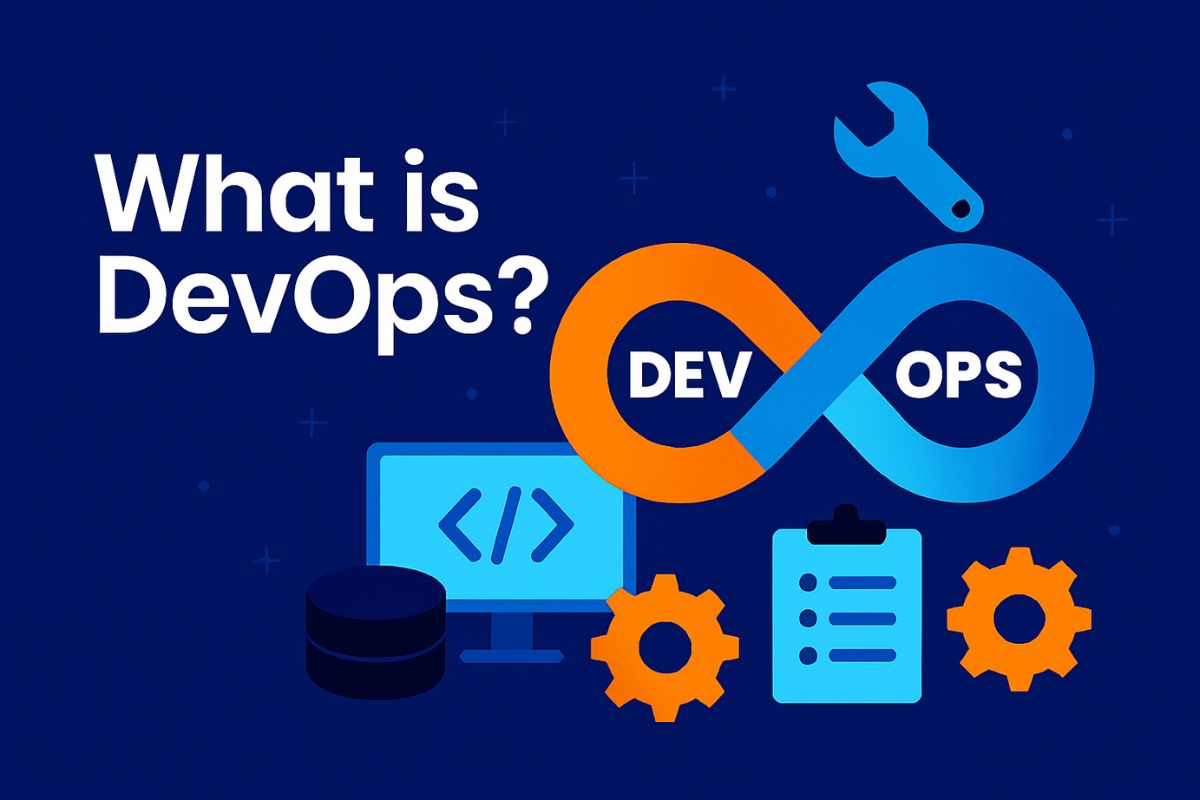DevOps is a collaborative software development approach that bridges the gap between development and IT operations, aiming to deliver faster, better-quality software. This blog explains what DevOps is, its lifecycle, tools, benefits, challenges, and how to start a DevOps career in 2025. Perfect for beginners, professionals, and career switchers.
In the fast-moving world of software and IT, traditional development and operations models are no longer enough. Businesses need speed, reliability, and continuous improvement to stay competitive.
This is where DevOps comes in.
DevOps isn’t just a buzzword — it’s a cultural and technical shift that integrates development (Dev) and operations (Ops) to improve collaboration, automate processes, and accelerate delivery.
In this beginner-friendly guide, you’ll discover what DevOps is, how it works, its benefits, tools, challenges, and how to build a successful DevOps career in 2025.
What is DevOps?
DevOps Meaning & Definition
DevOps is a set of practices, tools, and cultural philosophies that combine software development and IT operations. Its goal is to shorten the development lifecycle and provide continuous delivery (CD) with high software quality.
Instead of developers writing code and handing it off to operations for deployment, DevOps encourages collaboration, automation, and monitoring across all stages of the software lifecycle.
“DevOps is not a tool, it’s a mindset — one that empowers faster innovation, reliable deployment, and continuous feedback.”
Brief History of DevOps
- Coined around 2009 at DevOpsDays Belgium
- Born out of Agile methodologies
- Grew rapidly with the rise of cloud computing, containers, and CI/CD pipelines
The DevOps Lifecycle: How It Works
DevOps follows a continuous lifecycle, often represented as an infinity loop:
The 8 Key Stages of the DevOps Lifecycle:
| Stage | Description |
|---|---|
| 1. Plan | Define requirements, features, and tasks |
| 2. Develop | Code is written, peer-reviewed, and version-controlled |
| 3. Build | Automated build process converts code to deployable artifacts |
| 4. Test | Automated/unit/integration testing ensures quality |
| 5. Release | Code is staged for production release |
| 6. Deploy | Code is deployed using automation or containerization |
| 7. Operate | Application is monitored in production |
| 8. Monitor | Continuous monitoring, feedback loops, performance tracking |
Key Benefits of DevOps
| Benefit | Description |
|---|---|
| Faster Delivery | Quicker release cycles and faster time to market |
| Better Quality | Continuous testing improves software reliability |
| Improved Collaboration | Devs and Ops work as one team |
| Automation | Reduces manual errors and saves time |
| Scalability | DevOps tools help scale services efficiently |
| Continuous Feedback | Real-time feedback from users and systems |
| Cost Efficiency | Fewer bugs, faster fixes, and optimized resource use |
Popular DevOps Tools in 2025
Tools by Stage
| Stage | Tools |
|---|---|
| Planning | Jira, Trello, Azure Boards |
| Development | Git, GitHub, GitLab, Bitbucket |
| Build & Integration | Jenkins, Travis CI, CircleCI |
| Testing | Selenium, JUnit, TestNG |
| Release & Deploy | Docker, Kubernetes, Helm |
| Monitoring | Prometheus, Grafana, ELK Stack, New Relic |
| Collaboration | Slack, Microsoft Teams |
Bonus Tools
- Terraform – Infrastructure as Code (IaC)
- Ansible / Puppet – Configuration Management
- AWS CodePipeline – Fully managed CI/CD on AWS
DevOps Culture and Best Practices
DevOps Mindset
- Collaboration between devs, testers, and ops
- Blameless postmortems after failures
- Continuous learning and process improvement
- Shared responsibility for application performance
Best Practices
- Automate everything (builds, tests, deployments)
- Use Infrastructure as Code (IaC)
- Embrace continuous integration and delivery
- Implement real-time monitoring and alerts
- Foster a feedback-driven culture
DevOps vs Traditional IT
| Feature | DevOps | Traditional IT |
|---|---|---|
| Team Structure | Unified Dev + Ops | Separate Dev & Ops |
| Delivery Speed | Continuous | Slow, in phases |
| Collaboration | High | Low |
| Automation | Extensive | Limited |
| Deployment | Frequent & automated | Manual & scheduled |
| Feedback | Real-time | Post-deployment |
Challenges in Adopting DevOps
| Challenge | Solution |
|---|---|
| Cultural Resistance | Train teams, promote collaboration |
| Tool Integration Complexity | Use platforms like GitLab or Azure DevOps |
| Skill Gaps | Upskill via courses, certifications |
| Security Concerns | Implement DevSecOps practices |
| Legacy Infrastructure | Gradually migrate to modern, cloud-based systems |
DevOps Career Opportunities in 2025
Top Roles
| Role | Description |
|---|---|
| DevOps Engineer | Manages CI/CD, automates processes |
| Site Reliability Engineer (SRE) | Maintains high system availability |
| Release Manager | Oversees build & deployment pipelines |
| Cloud Engineer | Manages cloud infrastructure (AWS, Azure, GCP) |
| Automation Architect | Designs automation frameworks |
In-Demand Skills
- CI/CD pipelines
- Cloud platforms (AWS, Azure, GCP)
- Containerization (Docker, Kubernetes)
- Infrastructure as Code (Terraform)
- Scripting (Python, Bash)
Certifications to Consider
- AWS Certified DevOps Engineer
- Microsoft Certified: DevOps Engineer Expert
- Docker & Kubernetes Certifications
- Google Cloud DevOps Engineer
Free Resources & Learning Tools
| Platform | Features |
|---|---|
| freeCodeCamp | Full-stack DevOps learning paths |
| Kubernetes Official Docs | Best for real-world deployment |
| GitHub Learning Lab | Hands-on Git & CI/CD training |
| Linux Foundation Courses | Industry-verified DevOps training |
| Google Cloud Skills Boost | Free DevOps & cloud labs |
Expert Tips & Common Mistakes to Avoid
Tips
- Start with Git + GitHub + Jenkins
- Learn one cloud platform (AWS or Azure)
- Build mini projects to practice CI/CD
- Use Docker + Kubernetes for container deployment
- Document everything you do (logs, changes, feedback)
Mistakes to Avoid
- Ignoring the “Ops” part of DevOps
- Skipping security (DevSecOps is critical)
- Using too many disconnected tools
- Automating everything without monitoring
- Rushing into DevOps without planning the culture shift
Conclusion
DevOps is more than a buzzword — it’s a powerful collaboration-focused methodology that accelerates development, reduces errors, and improves customer satisfaction. Whether you’re a beginner exploring IT careers, a developer wanting to scale, or a business leader aiming to modernize, embracing DevOps in 2025 is a smart move.
By combining the right tools, mindset, and practices, DevOps helps teams deliver faster, smarter, and better.
FAQs
1. What is DevOps in simple terms?
DevOps is a way of working where software developers and IT operations teams collaborate, automate, and deliver software faster and more reliably.
2. Is DevOps a good career option in 2025?
Yes, DevOps is in high demand globally. Companies need DevOps engineers to automate, deploy, and manage modern cloud-based applications.
3. Which tools are used in DevOps?
Popular tools include Jenkins, Docker, Kubernetes, GitHub, Terraform, Prometheus, and AWS CodePipeline.
4. Do I need coding to learn DevOps?
Basic scripting (like Python, Bash) is helpful, but you don’t need deep coding knowledge to start learning DevOps.
5. How is DevOps different from Agile?
Agile focuses on software development, while DevOps covers the entire lifecycle — from development to deployment and monitoring.
6. What are the top DevOps certifications?
Top certifications include AWS DevOps Engineer, Microsoft DevOps Expert, Docker Certified Associate, and Google DevOps Engineer.
7. Can I learn DevOps for free?
Yes! Many platforms like freeCodeCamp, GitHub Labs, and YouTube offer beginner-friendly DevOps tutorials and tools.



